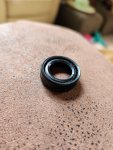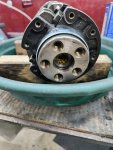I have my B7100 engine completely disassembled and I could use some advice. Attached are the pics.
After removing the crank I found this small seal laying in the block. I assume its the seal for where the output shaft inserts into the rear of the crankshaft. I have a new seal but not sure of its orientation. I think the face shown in the pic faces towards the block?
Best method for removing the bronze bushing in the back of the crank? Blind hole bearing puller?
Lastly, the wear sleeve on the rear of the crank. The wear pattern cannot be felt with a fingernail. Is it normally replaced? If so it seems that it could be flipped over and reused but I don't know. If it should be replaced is it removed with a bearing puller? I looked at the parts manual and I don't see an o-ring for a seal to the crank. Loctite?
Thanks for your help.
Sorry for the late reply just caught this.
Spring side out on that seal, it keeps dust out.
Bronze bushing removal, a tight fitting dowel, rod, or bolt.
Fill the space inside the bushing with grease then use the dowel or rod to drive the bushing out.
Yes you can flip the wear sleeve, if you don't feel a lip, I wouldn't bother.
I use a little RTV to seal it to the crank.




